Occupational environment monitoring at the factory producing steel
99,000 ₫
Note: The above price is calculated for one sample, the price may fluctuate depending on the area of the environment to be monitored and the movement of the market. For more accurate price support, please refer to the quotation table or contact directly with our consulting staff.
Environmental monitoring of steel manufacturing factories is a session of collecting, analyzing, and evaluating factors in the workplace that may be harmful to the health of workers.
Table of Contents
Toggle1. Overview of Steel Manufacturing Factories
a. What is a Steel Manufacturing Factory?
A manufacturing factory for steel is an industrial facility designed and built to produce steel from raw materials such as iron ore, carbon, and other metallic compounds. The steel production process in a factory involves multiple complex technical stages to transform raw materials into high-quality steel.
Steel manufacturing factories are large-scale facilities that employ complex technologies and equipment such as blast furnaces, steelmaking furnaces, crushers, cutters, bending machines, and process control systems. The steel production process requires strict control and compliance with industrial safety standards to ensure efficiency and worker safety.

b. Production stages in a steel manufacturing factory
Production stages in a steel manufacturing factory may vary depending on the production method and specific steel product. However, below is a summary of the main stages in steel production:
- Ore smelting: Iron ore (e.g., ore from iron mines) is melted in a blast furnace. During this process, iron ore reacts with coke and carbon monoxide to produce hot pig iron (liquid iron containing carbon and other impurities).
- Pig iron refining: The hot pig iron is transferred to a pig iron refining furnace, where heating and chemical treatment separate iron from impurities such as sulfur, silicon, and carbon.
- Steelmaking: Refined pig iron is transferred to a steelmaking furnace. During this stage, carbon content and other alloying elements are controlled and adjusted to produce steel with specific composition and properties.
- Steel casting: The molten steel from steelmaking is cast into desired shapes and sizes. Two main casting methods are continuous casting and traditional casting.
- Hardening: Steel is hardened to improve mechanical properties and corrosion resistance. Hardening may include thermal hardening, chemical hardening, or a combination of both.
- Processing and finishing: Steel products may be processed and finished through cutting, bending, welding, grinding, coating, and painting. This stage produces steel products with specific shapes and technical properties.

c. Machinery used in steel manufacturing factories
Steel manufacturing factories use various machines and equipment to carry out production and processing stages. Common machinery includes:
- Blast furnace: Used to melt iron ore and react it with coke and carbon monoxide to produce hot pig iron. The blast furnace has a combustion system and gas control system to regulate the smelting process.
- Pig iron refining furnace: Used to refine hot pig iron from iron ore. This furnace has refractory lining and fuel systems to maintain high temperatures and control the refining process.
- Steelmaking furnace: Used to produce steel from refined pig iron. It has fuel systems and precise temperature controls to manage chemical composition and mechanical properties of steel.
- Crusher: Used to crush and grind raw materials like iron ore and coke before entering the blast furnace.
- Rolling mill: Used to roll and shape steel into sheets, pipes, wires, and bars. Rolling mills may have multiple rolls and drive systems to produce different shapes and sizes.
- Cutting, bending, and welding machines: Used to cut, bend, and weld steel products into components and structures as required.
- Coating machine: Applies protective coatings on steel surfaces to prevent corrosion and produce a shiny finish.
- Inspection and measurement equipment: Used to measure and check the quality of steel products, including dimensions, mechanical properties, and alloy composition.

d. Occupational diseases in steel manufacturing factory workers
Workers in steel manufacturing factories may be exposed to certain occupational diseases due to the specific industrial environment. Common occupational diseases in steel production include:
- Metal dust lung disease: Workers may inhale metal dust such as silicon, aluminum, and iron. This can lead to pneumonia, metal lung disease, and pulmonary fibrosis.
- Noise-induced hearing loss: Steel production generates high noise from machinery, furnaces, and fabrication processes. Continuous exposure can cause hearing damage, reduced hearing ability, and deafness.
- Respiratory diseases: Toxic gases such as carbon monoxide, nitrogen oxides, manganese fumes, and nickel fumes may be present. Long-term inhalation can cause lung diseases and other respiratory issues.
- Skin diseases: Exposure to chemicals such as acids, alkalis, and cleaning agents may cause skin irritation, dermatitis, and eczema.
- Fire and explosion hazards: Exposure to flammable gases like methane and hydrogen may occur. Without careful management, fires or explosions can endanger workers.
- Musculoskeletal disorders: Jobs involving heavy lifting or awkward positions for extended periods can cause spinal and joint injuries.

e. Common types of steel on the market
There are various types of steel, each with unique chemical composition and mechanical properties. Common types include:
- Carbon steel: Contains 0.1% to 2.1% carbon. Widely used in construction, automotive, mechanical, and household industries.
- Stainless steel: Steel alloy with at least 10.5% chromium. Corrosion and oxidation resistant, suitable for food, medical, architectural, and interior applications.
- Alloy steel: Steel with additional elements such as nickel, chromium, molybdenum, and vanadium. High strength and special mechanical properties for demanding industries like bridges, machinery, aerospace, and shipbuilding.
- Steel plate: Sheets of steel ranging from thin to thick, used in construction, mechanical engineering, shipbuilding, and infrastructure.
- Steel pipe: Pipes of varying diameters and thicknesses, used in oil and gas, construction, water supply, and wastewater treatment.
- Steel sections: U, I, H, and other shapes for structural components such as columns, beams, and frameworks.
- Forged steel: Produced by hot forging, resulting in high-strength products with excellent mechanical properties. Used in engine shafts, machinery parts, and hand tools.
2. Overview of Occupational Environment Monitoring Services
a. What is occupational environment monitoring in steel factories?
Occupational environment monitoring (or workplace environmental measurement) in steel factories involves collecting, evaluating, and analyzing environmental factors to take timely measures, minimize health risks, and prevent occupational diseases. Monitoring is mandatory for steel factories.
This is crucial for protecting workers’ health, as employees are the main resource generating profit for the business. Continuous exposure to risks above allowable limits may affect health and cause occupational diseases.
REGISTER FOR OCCUPATIONAL ENVIRONMENT MONITORING SERVICE
b. An Toan Nam Viet’s occupational environment monitoring program
An Toan Nam Viet’s program is developed by monitoring engineers specializing in occupational safety and environmental protection. It uses modern measurement methods to monitor air, water, microclimate, physical factors, and dust in the workplace. This program is critical for ensuring a safe work environment and protecting workers’ health.
Additionally, it supports research and development of solutions to improve workplace environmental quality. With a dedicated and professional team, An Toan Nam Viet’s exclusive program is a breakthrough in occupational safety and environmental management in Vietnam.

c. Standardization in workplace environmental measurement
Standardization ensures the accuracy and reliability of measurements. An Toan Nam Viet follows recognized standards and procedures from the Ho Chi Minh City Department of Health. Measurements are conducted by highly trained monitoring specialists to ensure reliable data for decision-making on worker health and environmental protection.
d. Reporting results of monitoring in steel factories
Monitoring results are prepared according to Form No. 04, Appendix III of Decree 44/2016/ND-CP in two copies: one for the contracting factory and one retained by the monitoring organization.
Records must be kept indefinitely according to law.

e. Frequency of occupational environment monitoring according to law
According to Clause 2, Article 18, Labor Safety and Hygiene Law 84/2015/QH13, employers must conduct occupational environment monitoring at least **once per year**.
f. Deadline for submitting monitoring results according to law
Reports must be submitted by December 31 annually. Factories must submit monitoring results to the local Department of Health where their main facility and employees are located.
If there are changes in technology, production processes, or workplace upgrades introducing new hazards, factories must update occupational hygiene records regarding harmful factors requiring monitoring.
g. Penalties for violations regarding occupational environment monitoring for employers
According to Article 27, Decree No. 12/2022/ND-CP dated January 17, 2022:
- Clause 2: Fines from 2,000,000 – 5,000,000 VND for not publicly notifying workers about monitoring results and hazard assessments immediately after completion.
- Clause 3: Fines from 20,000,000 – 40,000,000 VND for failing to conduct occupational environment monitoring as required by law.
- Clause 4: Fines from 40,000,000 – 60,000,000 VND for colluding with monitoring organizations to falsify results without reaching criminal liability.
3. Harmful Environmental Factors for Workers in Steel Manufacturing Factories
Workers in steel manufacturing factories may be exposed to various harmful environmental factors that can affect their health. Below are some common harmful environmental factors in the steel production industry:
- Metal dust: Steel production processes often generate metal dust such as iron, aluminum, silicon, and other metal compounds. Inhaling metal dust can cause respiratory irritation and lead to respiratory problems.
- Toxic fumes and gases: During steel production, toxic fumes and gases may be present, such as CO (carbon monoxide), SO2 (sulfur dioxide), NOx (nitrogen oxides), and SOx (sulfur oxides). Long-term inhalation of these substances can cause respiratory, eye, skin, and nervous system problems.
- High temperatures: The working environment in steel manufacturing factories is often very hot. Workers face risks of burns, heat stress, and dehydration.
- Noise: Steel production generates high noise from machinery, equipment, and fabrication processes. Continuous high-intensity noise can cause hearing damage and auditory problems.
- Chemicals: Chemicals such as acids, alkalis, solvents, and cleaning agents are used in steel production. Exposure to these chemicals can cause skin irritation, dermatitis, and other health issues.
- Raw materials and by-products: Raw materials like iron ore and coke, as well as by-products such as fly ash and waste sand, may contain hazardous substances and cause environmental pollution.
- Fire and explosion risks: During steel production, there is a risk of fire and explosions from methane and other flammable materials. Explosions can cause serious injuries and endanger lives.
REGISTER FOR WORKPLACE ENVIRONMENT MONITORING SERVICE
4. Measures to Improve the Working Environment in Steel Manufacturing Factories
Improving the working environment in steel manufacturing factories is an important process to protect workers’ health and ensure safety. Below are some measures to enhance the working environment in steel factories:
- Safety management system: Implement an occupational health and safety management system, such as ISO 45001, to ensure compliance with labor safety regulations and control environmental risks.
- Information and education: Provide training on occupational safety and health for all employees, including work processes, potential risks, and how to use personal protective equipment properly.
- Use of protective equipment: Ensure employees use full and correct personal protective equipment such as helmets, masks, gloves, safety goggles, and safety shoes to protect against potential hazards during work.
- Waste and pollution management: Apply waste and pollution management measures, including proper waste treatment, controlling air and water pollution, and ensuring compliance with relevant regulations and standards.
- Production process adjustment: Improve production processes by using cleaner technologies, reducing emissions and noise, and using environmentally friendly materials.
- Raw material and chemical management: Properly manage and store raw materials and chemicals in the factory to reduce health and environmental risks.
- Periodic equipment inspection and maintenance: Regularly inspect, maintain, and repair equipment and machinery to ensure safe and efficient operation.
- Promote safety awareness: Create a safety-oriented work culture that promotes safety awareness and compliance with safety rules among all employees.
- Monitoring and evaluation: Conduct monitoring, measurement, and evaluation of environmental and occupational health indicators to identify issues and implement appropriate improvement measures.
- Regularly conduct workplace environment monitoring in factories, collect and analyze harmful factors affecting workers, then adjust to reduce risks and prevent occupational diseases.
5. Benefits of Regular Monitoring of Steel Manufacturing Factories
An Toan Nam Viet provides excellent benefits to your business when using workplace environment monitoring services according to Decree 44/2016/ND – CP on the management and control of harmful factors in the working environment affecting workers.
- Your business can proactively control harmful factors in the factory or production site.
- Receive consultation and recommendations on measures to reduce harmful factors and improve the quality of the working environment.
- Indirectly protect human resources, the key factor in the company’s development process.
- Minimize the impact of occupational diseases on human health, thereby reducing future treatment costs.
- Improve workers’ health, leading to better product quality and maintained production output.
- Comply with labor safety laws, avoiding legal risks.
- Enhance credibility and professionalism in all aspects, thereby elevating your company’s brand.
Nam Viet’s environmental monitoring service is a solution to reduce occupational disease risks, contributing to a clean and high-quality working environment.

6. National Workplace Environment Monitoring Center
Workplace Environment Monitoring Center of Nam Viet is a professional unit for supervising and measuring the quality of workplace environments across all provinces in Vietnam. With a team of experienced monitoring specialists, the center uses modern measuring equipment to ensure accuracy and reliability.
In addition to providing monitoring services, the center supports clients in planning, managing, and following up on workplace environmental issues. Following the motto “customer-centric,” the center prioritizes client satisfaction, meets all customer needs, and commits to providing the best solutions for businesses.
REGISTER FOR WORKPLACE ENVIRONMENT MONITORING SERVICE
With investments in technology, equipment, and human resources, Nam Viet’s monitoring center has become one of the reputable units in workplace environment monitoring in Ho Chi Minh City, with the following objectives:
- We always value brand reputation and the quality of our service products.
- We provide clients with the best and most suitable solutions possible.
- Along with a team of experienced Masters and Engineers, committed to protecting the environment and benefiting businesses.
- By choosing Nam Viet Environmental Monitoring, your company will receive professional service from experts in the field and enjoy the best cost advantages.
The workplace environment monitoring process at Nam Viet includes the following basic steps:
- Before conducting monitoring, we ensure that all machinery and equipment are calibrated and adjusted according to legal regulations.
- Carry out the workplace environment monitoring process as committed to the Department of Health.
- Report workplace environment monitoring results honestly to the employer.
- If the monitoring results do not ensure safety for workers, Nam Viet will support corrective solutions and the workplace will implement:
- Implement measures to improve working conditions to minimize the impact of harmful factors and prevent occupational diseases.
- Organize health checks to detect occupational diseases and related illnesses early for employees in unsafe working conditions.
- Provide in-kind compensation to workers according to labor law regulations.

7. Workplace Environment Monitoring Price List
To help businesses conduct workplace environment monitoring professionally and effectively, Nam Viet provides clients with a comprehensive and reasonably priced monitoring service price list.
- Our price list provides detailed information about the costs of the monitoring services we offer, including travel, measurement, analysis, and reporting. Clients can be fully assured of the accuracy and reliability of the monitoring reports we provide.
- We commit to offering competitive and reasonable prices in the market and are always ready to consult and answer any questions about monitoring services promptly and professionally.
- With Nam Viet’s monitoring price list, clients can easily choose service packages that fit their needs. We commit to delivering the highest satisfaction with professional service quality.
No comments yet

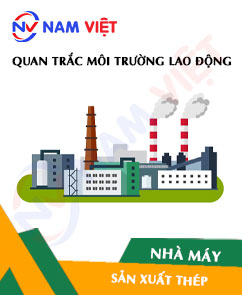
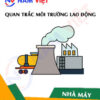
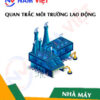





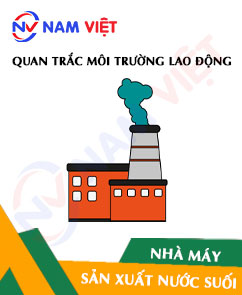
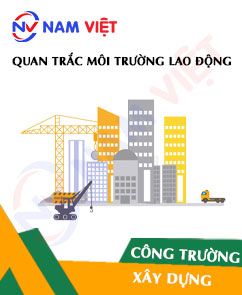
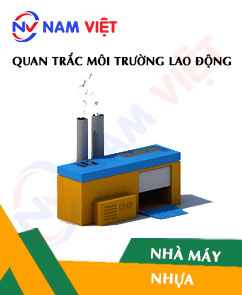
Review Occupational environment monitoring at the factory producing steel
There are no reviews yet.